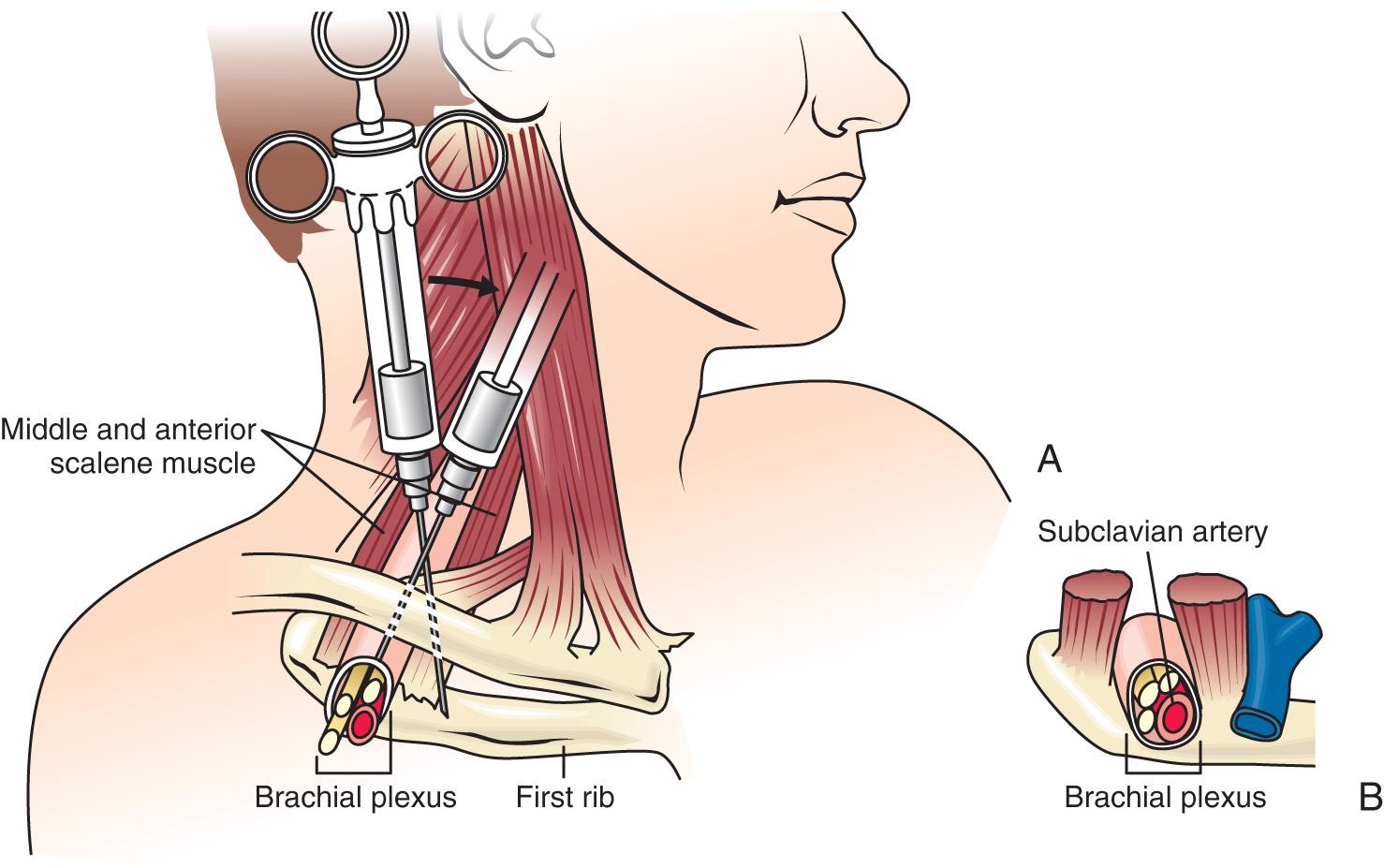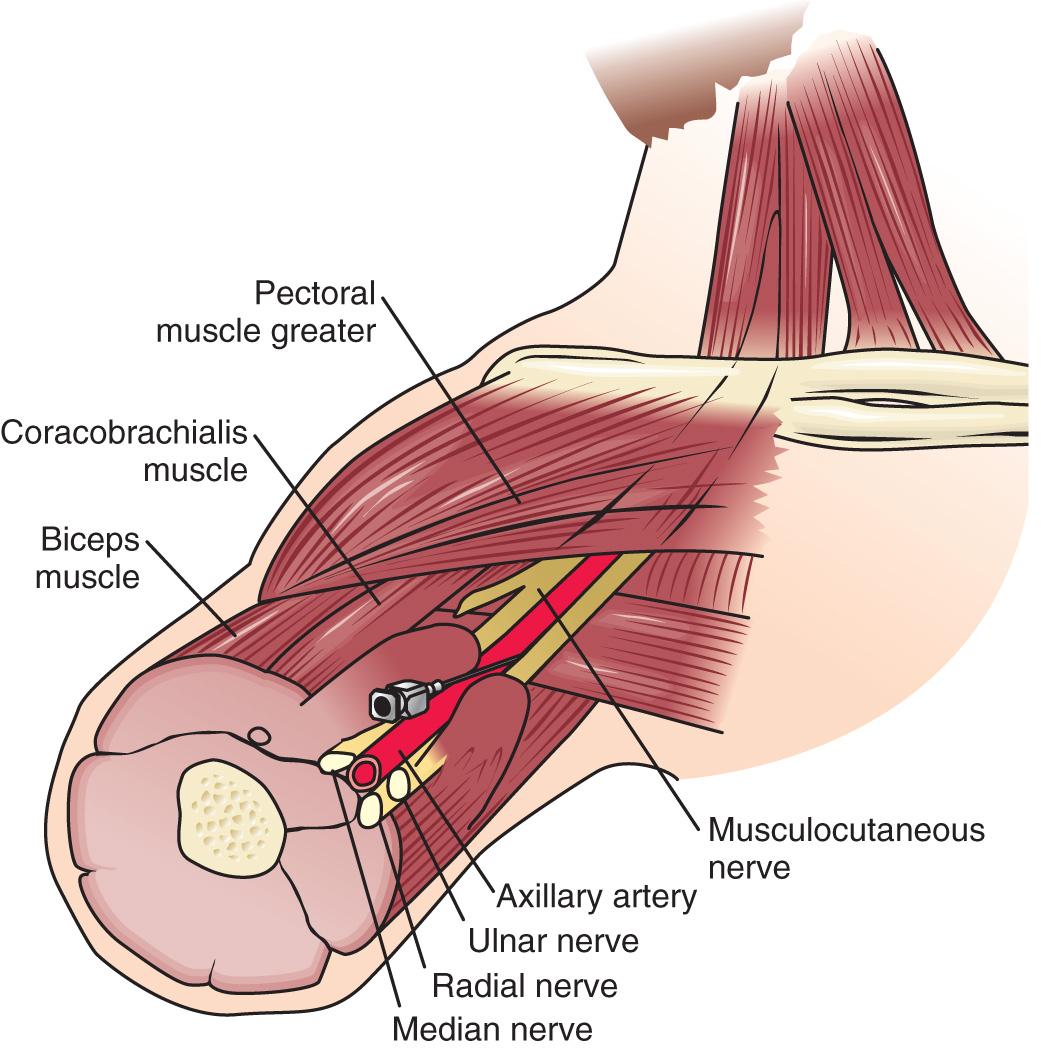Physical Address
304 North Cardinal St.
Dorchester Center, MA 02124
Orthopedic procedures for the elbow are well suited to regional anesthetic techniques. Continuous catheter techniques provide postoperative analgesia and allow early limb mobilization. In addition to intraoperative anesthesia, brachial plexus and peripheral nerve blocks may also be used in the treatment and prevention of reflex sympathetic dystrophy. Conversely, although the benefits of regional anesthesia in this patient population are well established, the operative site may be adjacent to neural structures, as with total elbow arthroplasty or supracondylar fractures. For example, ulnar nerve dysfunction may occur in up to 10% of patients undergoing elbow arthroplasty (see Chapter 99 ). Early diagnosis and intervention are paramount in reducing the severity of nerve injury; assessment of neurologic function would not be possible in the presence of a regional block. Thus the anesthetic and analgesic management is based on the patient's evolving neurologic status (including the need for serial neurologic examinations, the anticipated rehabilitative goals, and history of side effects or interactions to systemic analgesics). Selection of regional anesthetic technique, careful patient positioning, and serial postoperative neurologic examinations are required to reduce the incidence of neurologic dysfunction while optimizing surgical outcome.
Surgical procedures for the distal humerus, elbow, and proximal radius and ulna are commonly performed with regional anesthetic techniques. The brachial plexus may be blocked by four distinct approaches. Advances in needles, catheters, nerve stimulator technology, and ultrasound guidance have facilitated the localization of neural structures and improved success rates. Selection of regional technique is dependent on the surgical site ( Table 13.1 ). For surgery on the elbow, the supraclavicular ( Fig. 13.1 ), infraclavicular, or axillary ( Fig. 13.2 ) approaches are ideal because they provide adequate blockade of the lower trunk, which remains unblocked with the more proximal interscalene technique. Supraclavicular, infraclavicular, and axillary approaches to the brachial plexus are reliable and provide consistent anesthesia to the four major nerves of the brachial plexus: the median, ulnar, radial, and musculocutaneous nerves. With the supraclavicular approach the brachial plexus is blocked at the level of the proximal divisions, where it is compactly arranged. There are several advantages to the supraclavicular brachial plexus technique, including neutral position of the arm, quick onset of blockade, shallow needle approach with good ultrasound visualization, and a very homogeneous block. Limitations of this approach include phrenic nerve block and the risk of pneumothorax. Special consideration must be given to patients who could not tolerate the respiratory distress that may accompany a pneumothorax or phrenic nerve block, such as those with severe respiratory disease. The infraclavicular approach to the brachial plexus decreases the risk of pneumothorax, and the axillary approach eliminates the risk altogether, while reliably providing adequate anesthesia for surgery near the elbow. The infraclavicular approach to brachial plexus block allows local anesthetic injection near the level where the musculocutaneous and axillary nerves branch off the plexus. This approach is more proximal than the axillary technique and more distal than the supraclavicular approach, thus leading to blockade of all the nerves derived from the plexus but with a lower incidence of pneumothorax or phrenic nerve involvement (see Fig. 13.2 ). As with the supraclavicular approach, the arm can remain in a neutral position. This approach is useful in patients requiring a continuous catheter technique, because maintaining an aseptic dressing at this site is much more practical than in the axilla. The various approaches to the brachial plexus blockade may be performed before surgical incision or postoperatively after upper extremity neurologic function has been determined.
| Brachial Plexus Technique | Level of Blockade | Peripheral Nerves Blocked | Surgical Applications | Comments |
|---|---|---|---|---|
| Axillary | Peripheral nerve | Radial, ulnar, median; musculocutaneous unreliably blocked | Surgery of forearm and hand, less used for procedures about the elbow | Unsuitable for surgery proximal to the middle portion of the humerus; patient must be able to abduct the arm to perform block |
| Infraclavicular | Cords | Radial, ulnar, median, musculocutaneous, and axillary | Surgery of elbow, forearm, and hand | Catheter site (near coracoid process) easy to maintain; no risk of hemothorax or pneumothorax |
| Supraclavicular | Distal end of trunk, proximal end of cord | Radial, ulnar, median, musculocutaneous, axillary | Surgery of middle portion of the humerus, elbow, forearm, and hand | Risk of pneumothorax—unsuitable for outpatient procedures; phrenic nerve paresis in 30% of cases |


Although preoperative brachial plexus block reduces the intraoperative requirement of volatile anesthetic and opioids, and in theory provides preemptive analgesia, postoperative evaluation of neurologic function is not possible until block resolution. In addition, few outcome studies exist comparing regional and general anesthesia specifically for surgery about the elbow. However, from extrapolation of the results of forearm and hand procedures under single-injection brachial plexus block versus general anesthesia, a regional technique is associated with increased analgesia, reduced opioid consumption and postoperative nausea and vomiting, and early hospital dismissal. Overall, there are early but no long-term benefits with a single-injection regional anesthetic technique compared with a general anesthetic. However, placement of an indwelling perineural catheter results in more substantial and lasting benefits, including avoidance of hospital admission/readmission, decreased opioid-related side effects and sleep disturbance, and improved rehabilitation. Thus anesthetic management of patients undergoing elbow surgery is focused on postoperative analgesia rather than intraoperative anesthesia to improve perioperative outcomes.
Patients undergoing major upper extremity surgery experience substantial postoperative pain. Thirty percent of patients undergoing ambulatory hand and elbow surgery reported moderate to severe pain at 24 hours postoperatively. Failure to provide adequate analgesia impedes early physical therapy and rapid rehabilitation, which are important for maintaining joint range of motion, facilitating hospital dismissal, and preventing readmission. Traditionally, postoperative analgesia following major upper extremity surgery was provided by intravenous patient-controlled analgesia (PCA). However, opioids do not consistently provide adequate pain relief and often cause sedation, constipation, nausea/vomiting, and pruritus. Recently, clinical series have consistently reported that continuous brachial plexus block provided a superior quality of analgesia and superior surgical outcomes compared with systemic opioids but with fewer side effects. These reports suggest that continuous peripheral techniques may be the optimal analgesic method following elbow surgery. Appreciation of the indications, benefits, and side effects associated with both conventional and novel analgesic approaches is paramount to maximizing rehabilitative efforts and improving patient satisfaction.
Multimodal analgesia is a multidisciplinary approach to pain management, with the aim of maximizing the positive aspects of the treatment while limiting the associated side effects. Because many of the negative side effects of analgesic therapy are opioid related (and dose dependent), limiting perioperative opioid use is a major principle of multimodal analgesia. Not surprisingly, the efficacy and side effects of analgesic therapy are major determinants of patient satisfaction. In a prospective survey of 10,811 patients, after adjustment for patient and surgical factors, moderate or severe postoperative pain and severe nausea and vomiting were associated with patient dissatisfaction. The use of single-injection and continuous brachial plexus techniques and a combination of opioid and nonopioid analgesic agents for breakthrough pain results in superior pain control, attenuation of the stress response, and a decrease in opioid requirements.
Become a Clinical Tree membership for Full access and enjoy Unlimited articles
If you are a member. Log in here